|
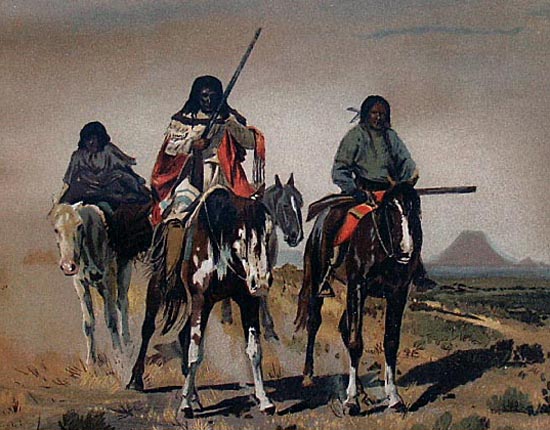
Shoshone Hunting Party by Peter Moran, 1890
The butte in the distance is Crowheart Butte at which
the Shoshone and their allies the Bannocks fought a battle in 1866
with the Crow for control of
the Wind River Valley. The Crow were beseiged on the butte but the Shoshone were unable to dislodge
the Crow. According to oral tradition, the Crow chief, Big Shadow (also called Big Robber), challenged Washakie, chief of the
Shoshone, to one-on-one combat to the death. If
Big Robber won, the Crow could go in peace. Big Robber was killed in the battle. Rather than scalping
his opponent, Washakie cut Big Robber's heart out and placed it on the end of his lance. As a sign of
respect for the courage of their opponent, the Shoshone later ate Big Robber's heart, thereby imparting his
courage to the Shoshone warriors. The question of whether the Crow chief was actually Big Shadow is subject to some
debate. It has also been contended that Big Shadow was killed in 1858 and that the name of the Crow chief killed at
Crowheart is unknown.
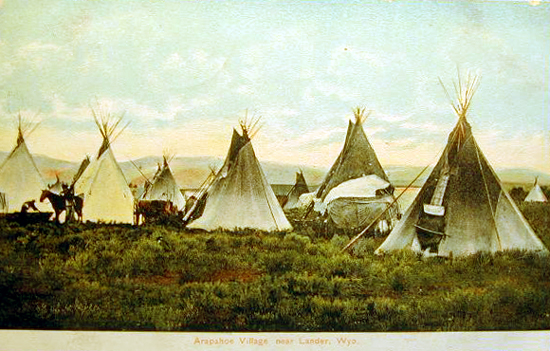
Arapaho tipis near Lander, 1907
In addition to the Shoshone, the other two principal tribes of Native Americans who made their home in
Wyoming are the Arapaho and the Crow. The Arapaho and the Shonshone
share the Wind River Reservation in the central part of the state. The Crow now make their home
southeast of Billings in Montana. The Shoshone at one time
wandered the great plains but were driven westward by the Atsina and Siksika. As the White Man settled the
continent, the eastern Indians were gradually driven westward. They, in turn, drove the Native
Americans who preceeded them into the Great Plains and the Plains Indians were driven westward to
the Rocky Mountains. The language of the Shosone is related to
that of the Comanche. The Arapaho speak an Algonquian language and are regarded as having
originated in Minnesota and gradually drifted to the south and west. The tribe is divided into
two, the Northern Arapaho in Wyoming and the Southern Arapaho in Oklahoma. The Arapaho in
Wyoming constitute the mother tribe with possession of the sacred symbols, a stone pipe, ear of corn,
and turtle.
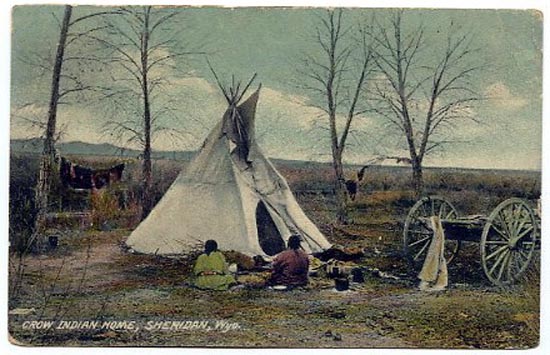
Crow Tipi near Sheridan, approx. 1907
The Crow at the time of the first exploration of Wyoming resided along the Bighorn, the yellowstone and Powder Rivers and hunted as far south
as the North Platte.
they are believed to have come from further to the east. They are related to the Sioux.
It is generally accepted that man was in what was to become Wyoming some 10,500 to 11,000
years ago. Some evidence may exist that man came to North America considerably earlier.
Different theories exist to explain migration from Asia – over a land bridge connecting
Siberia and then down coastal British Columbia or down an ice free corridor through the Yukon
and Alberta, or perhaps across the Pacific and northwardly from South America. Permanent
traces, such as the cliff dwellings and kivas of New Mexico, Utah, and Southern Colorado,
however, are not to be found in Wyoming. Instead, there will be found tipi circles, petroglyphs and
pictograhs, traces of early mining such as the
Obsidian Cliff of Yellowstone,
the Spanish Diggings near Manville, buffalo jumps, and the great Medicine Wheel to the
east of Powell.
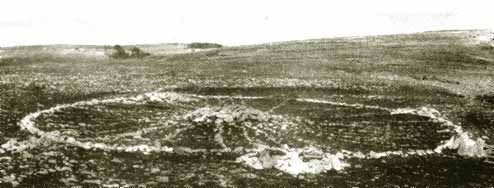
Big Horn Medicine Wheel, 1922.
Arrowheads made from obsidian from Yellowstone has been found as far east as Ohio, in
central Canada, and in Washington State. It has been speculated based on carbon dating that some
petroglyphs may be as old as ten thousand years and may be associated with the migration of the
Apache into the American Southwest. Other petroglyphs have been associated with the Algonquian. Generally, however, their origin and purpose is unknown.
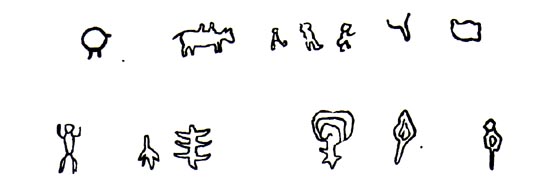
Sketch of petroglyphs by F. W. Bond, Yellowstone, 1873, as reproduced in Fourth Annual Report of the
Bureau of Ethnoloogy, J. W. Powell, Director, 1886.
The image on the upper left is that of a shield, an image now known as a Castle Gardens
Style pictograph. Shields are commonly found from southern Montana to central Wyoming and
have been dated to about 1000 years ago. They have been associated with Athapaskan hunters
and gathers, today represented by the Navajo and the Apache. The most famous of the shields
is the Great Turtle Shield discovered by J. David Love in the 1920’s. The image was stolen
but eventually recovered in 1941 by the Wyoming State Museum.
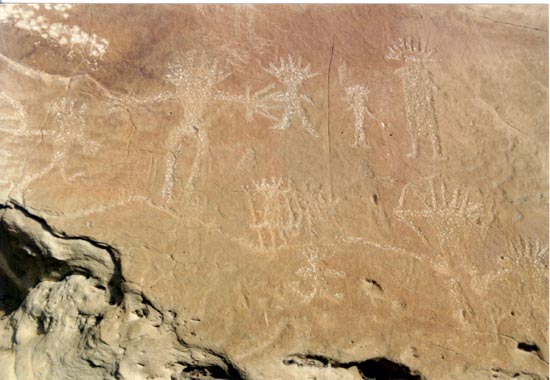
Petroglyphs near Cody. Photo Courtesy of
Michael Rooney.
Petroglyphs are fairly common in the Big Horn Basin including north of Powell, near Dubois,
the Hole in the Wall, and north of Hyattville. The most famous are those near
Thermopolis. Note: Destruction of Petroglyphs on public land is a
criminal offense.
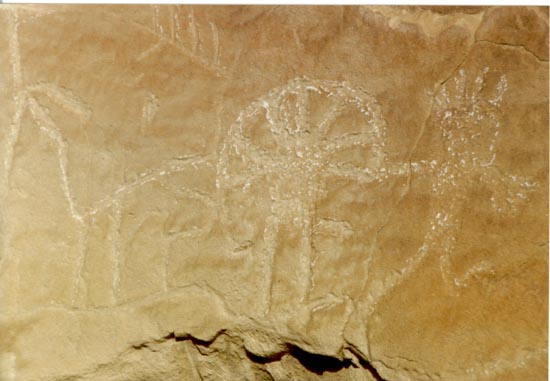
Petroglyphs near Cody. Photo Courtesy of
Michael Rooney.
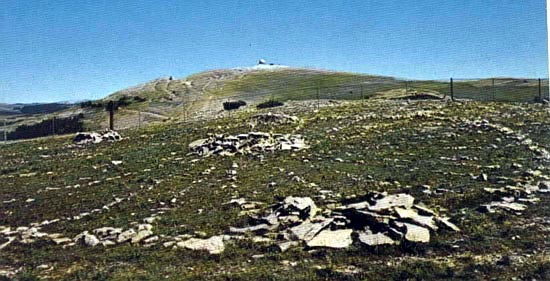
Big Horn Medicine Wheel.
To the east of Lovell, off US 14A lies the Medicine Wheel. The Wheel at 9,642 feet elevation contains 28 spokes with a central cairn. The wheel was 75 feet in
diameter. At the end of
one spoke extending to the south, according to a 1902 description, rested a buffalo skull
facing the rising sun. The Wheel is the southernmost of a number of similar wheels found primarily in southern
Alberta and Saskatchewan. The age of the Wyoming Medicine Wheel has been estimated at approximately 700 years.
Rodiocarbon dating of one at Majorville, Alberta, indicates that it was initially constructed about 4,500 years ago. One located at
Moose Mountain, Saskatchewan has been dated at approximately 2,200 years of age. The Moose Mountain Wheel was first described by George Dawson in the 1885
Geological and Natural History of Canada and the one in the Big Horns was described in 1895 in
Field and Stream
The Wheel is now surrounded by a chain link fence. The wheels have given rise to much unanswered fanciful speculation as to the purpose of, and who constructed,
the wheels. Thus, as an example, early speculation had it associated with Aztec religious ceremonies. See Proceedings and Collections of the
Wyoming State Historical Department, 1921-1923. Current thinking is that the
wheels are associated with the Blackfeet and may have a relationship with the Summer Solstice.
Next page: The Coming of the Horse, Indian dependence upon the bison.
|